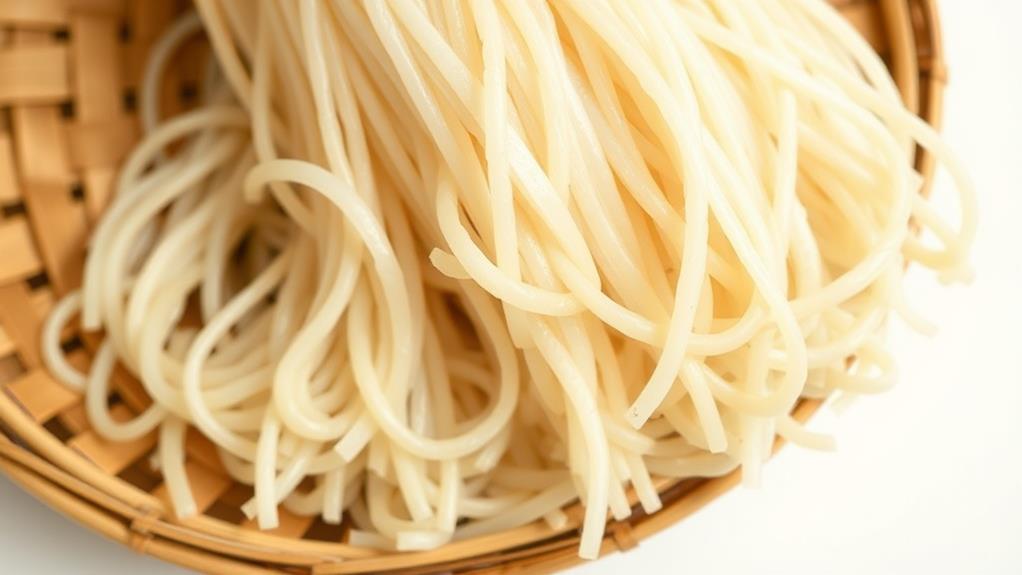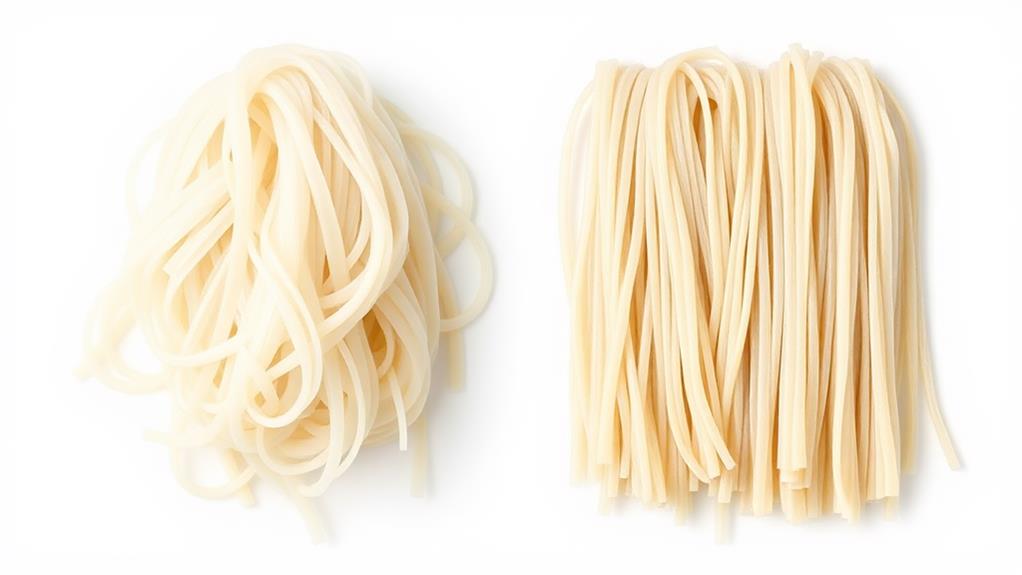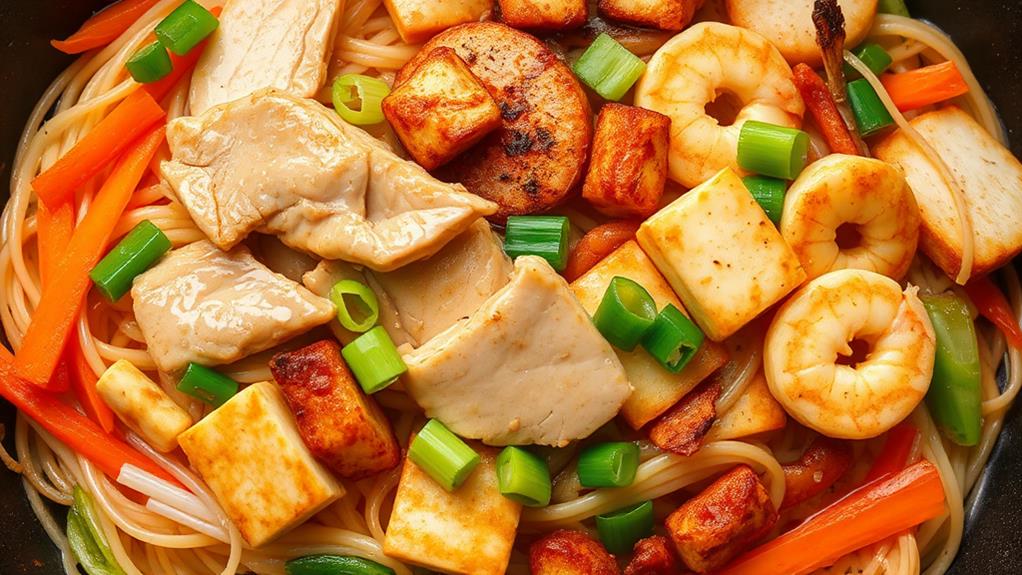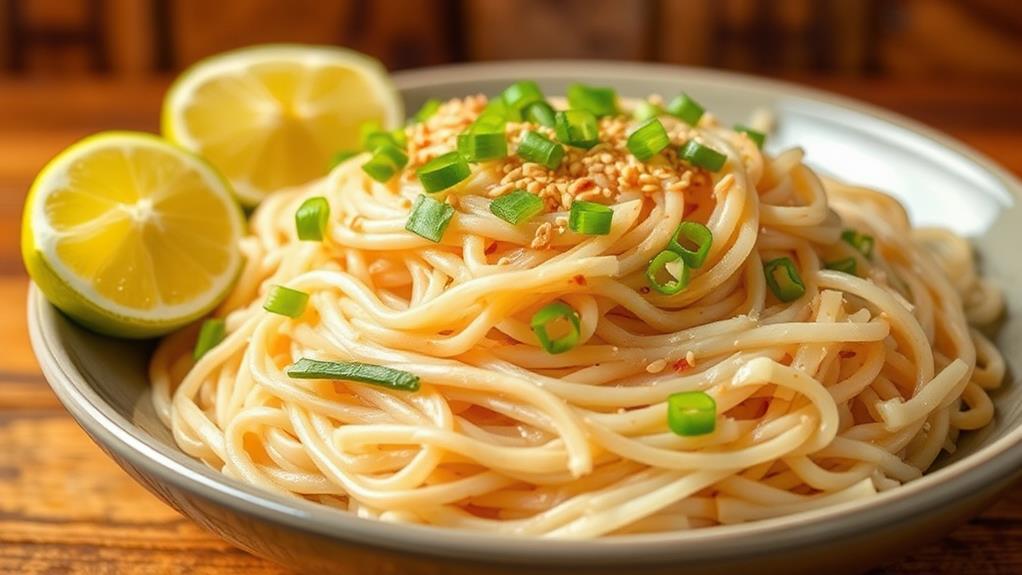Selecting the right type of rice noodles is crucial to creating an exceptional Pancit dish. Bihon noodles are the preferred choice, as they provide a chewy texture when cooked.
Pair these noodles with protein sources like chicken, shrimp, or pork to add depth to your dish.
Colorful vegetables like cabbage, carrots, and bell peppers add freshness and crunch to your Pancit.
A savory sauce made with soy sauce, dark soy sauce, oyster sauce, and chicken bouillon brings all the flavors together.
With these key ingredients in place, you'll be well on your way to crafting a mouthwatering Pancit dish that's full of flavor and texture.
Understanding Pancit Noodles

Pancit noodles are a staple ingredient in Filipino cuisine. They encompass various types of noodles, each with unique characteristics that influence the overall dish quality.
Bihon noodles, a thin rice vermicelli, are one of the most common varieties. Made from rice flour, bihon noodles have a distinct chewy texture that requires soaking rather than boiling before cooking.
Soaking bihon noodles is essential to achieve the right texture.
Other types of pancit noodles include canton noodles, which are thick and made from wheat flour, and Malabon noodles, which are thick and made from rice flour. Each type of noodle offers a distinct flavor and texture, affecting the overall taste of the dish.
For example, bihon noodles provide a lighter taste compared to the heartiness of canton noodles.
To get the best out of your pancit noodles, remember that they should absorb the flavors of the accompanying sauces and ingredients. This enhances the overall taste of the dish.
Choosing the right type of pancit noodle for your recipe is crucial to achieve the perfect balance of flavors.
Essential Ingredients for Pancit
Pancit's Core Ingredients
Noodles: Bihon noodles, thin rice vermicelli, provide a chewy texture when cooked.
Protein: Choose from chicken, shrimp, or pork to add protein to your pancit dish, depending on your personal preference or dietary restrictions.
Vegetables: Essential vegetables like cabbage, carrots, and bell peppers bring color, crunch, and nutritional value to the dish.
Sauce: A savory and umami-rich sauce is created by combining soy sauce, dark soy sauce, oyster sauce, and chicken bouillon.
Cooking Oil: Vegetable or canola oil is crucial for sautéing the garlic, onions, and proteins, ensuring a well-cooked and flavorful base for the dish.
With these ingredients, you'll be able to create a delicious and authentic pancit dish that's full of flavor and texture.
Selecting the Right Noodles

Selecting the Right Noodles for Pancit Bihon
When making Pancit Bihon, choosing the right noodles is crucial for an authentic and flavorful dish. Bihon noodles made from rice or cornstarch are the traditional choice. These thin, chewy noodles absorb flavors well, making them ideal.
To prepare bihon noodles, soak them in warm water for 8-10 minutes before cooking, as they don't require boiling.
If bihon noodles aren't available, Udon or chow mein noodles can be used as alternatives, offering different textures and flavors.
However, avoid using glass noodles, as their texture differs significantly and may not complement the dish's intended flavor profile.
Building Flavor With Aromatics
Building Flavor with Aromatics
To create a mouthwatering Pancit dish, flavorful aromatics are essential. These aromatics form the foundational flavor base for your Pancit.
Sauté garlic and onion until they're fragrant, as they provide the initial flavor profile. Adding ginger enhances the flavor, introducing a subtle warmth and complexity to the dish.
To add freshness and brightness, throw in some fresh herbs like celery leaves or green onions towards the end of cooking. This balances out the savory flavors.
Incorporate calamansi juice, a common ingredient in Filipino cuisine, which adds a tangy, citrusy flavor.
Seasoning is crucial. Use a combination of soy sauce and dark soy sauce to not only add flavor but also contribute to the dish's color and umami richness.
This creates a well-rounded flavor experience that complements the noodles. By incorporating these aromatics, you'll build a rich and complex flavor profile that elevates your Pancit dish.
Adding Protein and Vegetables

Adding Protein and Vegetables for a Nutritious Pancit
To make your Pancit dish more substantial and nutritious, add protein and vegetables. Choose from a variety of proteins like chicken, shrimp, or pork belly, depending on your personal preference or dietary restrictions.
Incorporate a mix of colorful vegetables, such as cabbage, carrots, bell peppers, snap peas, and onions, which add texture and flavor to the dish. These vegetables provide essential vitamins and minerals, ensuring balanced nutrition.
Sauté the proteins and vegetables together before adding the noodles to enhance flavors through caramelization and blending. Start by cooking harder vegetables like carrots, then add softer ones to ensure even cooking.
Balancing Seasonings and Sauces
Balancing Seasonings and Sauces
To create a harmonious balance of flavors in Pancit Bihon, combine soy sauce, dark soy sauce, and oyster sauce. These three ingredients provide umami and depth to the dish.
A small amount of sugar counteracts the saltiness of the soy sauce and enhances the overall flavor profile of the noodles.
Adding chicken bouillon or broth gives the noodles a rich layer of flavor and umami taste.
Calamansi juice or lemon juice, added towards the end of cooking, brightens the dish and adds a fresh citrus note that complements the savory elements.
Finally, season with black pepper to taste, providing a gentle heat that balances the sweetness and saltiness of the other ingredients.
Which Types of Rice Noodles Are Best for Making Pancit?
When preparing pancit, it’s important to choose the right types of pancit noodles. For a traditional pancit dish, thin rice noodles like “bihon” work best, as they absorb flavors well. If you prefer a thicker noodle, “canton” is a great option that adds a chewy texture to the dish.
Cooking and Serving Tips

Achieving Perfectly Cooked Pancit Rice Noodles
To ensure perfectly cooked Pancit rice noodles, attention to detail is crucial in the cooking and serving process. Soaking bihon noodles in warm water for 8-10 minutes maintains their delicate texture.
Cooking Techniques for Perfect Pancit
| Cooking Tips | Techniques | Benefits |
|---|---|---|
| Soak noodles | Soak bihon noodles in warm water | Maintains delicate texture |
| Stir-fry veggies | Start with hard veggies, add soft ones later | Even cooking, prevents overcooking |
| Use large pan | Use a large non-stick pan or wok | Prevents noodles from sticking together |
Stir-Frying for Even Cooking
When stir-frying, start with the hardest vegetables like carrots and cabbage, adding softer ones later to ensure even cooking and prevent overcooking. Using a large non-stick pan or wok prevents the noodles from sticking together during the cooking process, facilitating easier mixing of ingredients.
Enhancing Flavor
To enhance flavor, mix sauces including soy sauce, chicken bouillon, and calamansi juice before adding them to the noodles, allowing for a well-seasoned dish.
Serving Suggestions
Serve Pancit with fresh lemon or Calamansi wedges on the side to add a zesty finish that complements the dish's savory flavors.
Frequently Asked Questions
What Are the Ingredients in Rice Noodles?
Rice noodles are made from rice flour and water, making them a gluten-free option.
There are various types of rice noodles, including bihon, which is super thin, and thicker options like Malabon noodles, often used in seafood dishes.
These noodles are usually dried, so they need to be soaked in warm water before cooking.
Rice noodles are a versatile ingredient that can be experimented with in different ways, including various cooking methods, flavor variations, and regional styles to create a dish that suits your taste.
What Are Pancit Noodles Made Of?
Pancit noodles can be made from different ingredients, depending on the type.
Bihon noodles, a popular variety, are made from rice flour, which gives them a thin, chewy texture.
In contrast, Pancit Canton noodles are made from wheat flour and eggs, resulting in a thicker, heartier noodle.
Malabon noodles, another type, are made from thick rice flour and are often used in seafood-based dishes.
The choice of noodle type affects the dish's overall texture and flavor, offering a range of options to suit your taste preferences.
How to Cook Perfect Rice Noodles?
Get the soaking time right. For perfect rice noodles, soak them for 8-10 minutes. This ideal soaking time ensures they cook evenly and prevents them from becoming mushy.
After soaking, drain and rinse the noodles briefly to prevent clumping.
Add noodles at the right stage. For a great texture, add the noodles to your pan after cooking veggies and proteins. This helps the noodles absorb the flavors of the dish.
Keep the heat high to achieve a nice texture.
Incorporate flavor. To add extra flavor, incorporate some of the cooking broth or sauce into the noodles. This step enhances the overall taste of the dish.
What Are the Ingredients in Instant Rice Noodles?
Instant rice noodles primarily consist of rice flour and water. Some brands may include additional ingredients like salt, but the ingredient list is generally minimal.
This simplicity makes them gluten-free, a benefit for individuals with dietary restrictions.
Beyond the basic ingredients, it's up to the consumer to add flavor, texture, and nutrients. This can be achieved by incorporating seasoning packets, vegetables, and proteins.
To add variety, experiment with different instant noodle brands, flavor enhancement techniques, and cultural serving suggestions.
